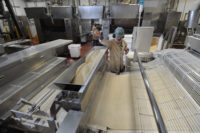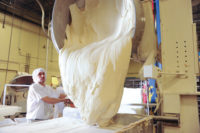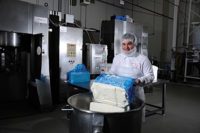Creating a pleasant stir in New York’s restaurants since 1987, Tom Cat combines the craftsmanship of artisan baking with a cupful of automation plus a pinch of top-quality ingredients to churn out incredibly fresh baguettes, rolls, buns and authentic country table breads seven days a week at its 45,000-sq.-ft. production facility in Long Island City, N.Y.
Tom Cat Bakery is a lion when it comes to variety. Producing an average of 350 stock-keeping units (SKUs) a day, from traditional pretzel rolls to French, German and Italian breads, wheat, rye and sourdough, the 45,000-sq.-ft. facility in Long Island City, N.Y., has been baking the artisan way for more than 26 years. Altogether, the bakery produces an incredible 450 different specialty items for New York’s leading restaurants, hotels and sandwich chains. And it does so seven days a week, 24 hours a day, and 365 days a year.
On the day of Snack Food & Wholesale Bakery’s visit, the plant was bustling as usual, producing assorted items such as country table breads, baguettes, boules, sandwich rolls and one of the hottest bread trends in New York and other cities: German Pretzel rolls.
Production is divided into two 12-hour shifts, though each employee doesn’t work that long. One shift starts at 11 a.m and the other at 11 p.m. Everything is staggered so that employees arrive and leave in waves to accommodate the dough’s long fermentation and proofing times. “It has to be that way,” explains James Rath, vice president and general manager. “The shifts aren’t what you’d call traditional.”
That’s because things in the artisan world are free-flowing, says Rosita Moreno, vice president of sales and marketing. Operators are stationed at different points on each line, depending on what’s being produced, to lend their artistic hands to the results. “Obviously, all of our breads aren’t ready at the same time, so we’re producing, packing and cleaning all day and night,” she says. “Everything is cyclic, so people come in to work at different times because it could be seven to 10 hours after a product is mixed that it’s ready to be baked.”
First in, first out
The first breads baked are the first to be packed and delivered, and all processes are performed in straightline fashion. The top priorities each day are to ensure that all orders are inspected and ready for delivery and that deliveries are made on time, Rath says.
Though a lot of production is done by hand, there are five rather sophisticated yet semi-automatic, stress-free or low-stress production lines, fed by two indoor silos that each hold 60,000 lb. of unbleached, unbromated flour. The flour is automatically sifted, scaled and pumped into one of several standalone spiral batch mixers. Water is also metered automatically and added to the mix. Semolina, rye and other specialty flours, as well as other dry, minor ingredients, are added by hand from bulk bags stored in a warehouse.
Equipment on the lines comes from various countries and was selected for specific types of breads and rolls. “We have systems from Germany, France, Italy, Austria, all over the world,” Rath says. “The only thing from the U.S. might be our slicing machines!”
A sixth line is in the works. “It’s not here yet, but we have some additional equipment on the way,” he adds. “We’ve automated bits and pieces, but none of the lines is what you’d call fully automated. The last piece of equipment we purchased was a machine to make silver-dollar-sized rolls because molding them by hand became too labor-intensive, and our other machines wouldn’t work with that small size roll.”
Tom Cat is also testing a machine that will help make product at higher speeds with the same ability to handle highly hydrated, long-fermented doughs, “which is always a challenge,” according to Rath. “We’re always trying new things to improve our processes.”
Mixing it up to wait
Each dough has a tracking sheet that indicates what time it was mixed, who mixed it, dough temperature, consistency and development according to its recipe. Batches range from 10-220 kilos (20-484 lb.), but usually weigh in at the high end of the range.
Production starts in the flour room, where the silos are positioned along one wall and racks of packaged ingredients, such as sunflower seeds, rye, herbs, caraway seeds, barley, poppy seeds, cocoa and many others, are stored. The different rooms in the plant are organized according to processes, such as mixing, makeup, proofing and baking.
The mixing staff arrives and receives dough production schedules for the shift, as well as formulations, ingredient preparation and mixing instructions. In the mixing room, several batches of dough that have been mixed for the first time sit in bins dotting the production room floor, undergoing the fermentation stage. “The mixers start off at a slow speed in the first of the two stages,” Rath explains. “Then, the mixture sits for about 30 minutes. We use the autolyse process, which really develops the flavor of the dough. When it’s ready, the dough goes through a second stage of mixing at a higher speed to develop the gluten.”
By giving the mixed flour and water time to go through autolysis, dough development is accomplished without any of the unpleasant effects of oxidation, he adds. “The autolyse step also gives the flour time to soak up moisture, which allows us to produce high performance doughs with higher absorptions. It not only reduces mixing time, but enriches the color of the bread,” Rath says. “We can add more water and give the dough more extensibilty, which is a characteristic we like.”
However, not all doughs (such as pretzel) require the autolyse process. Pretzel has a long proofing/retarding stage. “Where and how long the breads are fermented depends on the type of dough we’re working with,” Rath says. “Some doughs take four hours to ferment, depending on what the final product characteristics will be. So either way, we’ll take time to ferment on the front end or the back, because every bread has different qualities and requires different preparation methods, which give us different results in cell structure, crust, flavor color, texture. And, sometimes, we even come up with some great breads by accident.”
A few doughs are even mixed by hand. “Some artisan doughs really have to be treated gently,” he continues. “Preferments are very critical for achieving particular flavor and texture profiles.” Also enhancing taste is Tom Cat’s variety of starters, including a polish, wet and stiff levains and a biga.
After mixing is complete, fermentation, dividing, scaling and shaping take place. The dough is removed from the mixer and transferred over to the hopper of a chunker. Next, the chunked dough is put into bins that move through several semi-automatic stations for dividing, sheeting, rounding and shaping. Then the breads are transferred to assorted rooms for proofing, retarding, baking, cooling, packing and delviery. Shaping is performed either by hand or automatically, depending on the bread, but there is usually some operator involvement.
Different lines, different breads
Different lines are appropriate for certain types of bread. One line produces matzo using a press and manual docking and flouring. A lye applicator on a line running pretzel rolls showers the dough in a caustic sodium hydroxide solution, which gives the rolls their characteristic caramel/mahogany color and rich, pretzel flavor before the rolls are placed on a baking tray (the caustic solution bakes off). The pretzels are then are loaded into the oven, which bakes them, preserving the glossy mahogany sheen that results from the sodium hydroxide application.
Proofing is generally done at approximately 75+ deg. F and about 75% relative humidity (RH). Some products are proofed at room temperature and stay in the walk-in proof box for more than two hours, while others proof at lower temperatures for up to six hours. Then, the breads are deposited onto loader boards in the proofing area and often stay on the boards through retarding into loading of the ovens.
The baking room has a bank of rack ovens for softer sandwich-style breads and five stone-hearth deck ovens that bake breads right on the stone, which gives the crusts character, according to Rath. An automatic oven-loading system feeds breads into and out of the oven, automatically depositing them onto a deck. The unloader moves into the oven and like a giant peel slides beneath the breads, picks them up, deck by deck, and deposits them on a conveyor. “Each oven has seven levels, and we have 14 decks and 42 boards,” says Rath. Baking times and temperatures also vary, depending on what’s in the ovens, and temperatures range from 392-500 deg. F.
The ovens’ steam generator allows water droplets to condense on top of the bread's exterior, keeping it moist and preventing it from cracking while the bread expands.
After baking, the bread is placed on racks to cool down to 85-90 deg. F, for anywhere from 30 minutes to two hours, depending on the product. If slicing is required, the internal temperature of the bread is taken first—the denser the bread, the longer it takes to cool. Frozen goods are transferred to a blast freezer after cooling.
Operators then move the racks of cooled breads out to a manual packaging area, where they can be sliced if necessary, and load them by hand into large brown paper sacks or clear film bags that are clipped closed using a semi-automatic bag closer. All of the bags are labeled with the date, shift, product and quantity, and the label is scanned before the shipments leave on the trucks.
“We have a dedicated logistics program for all delivery stops and delivery windows,” Rath points out. “It really facilitates all of the of getting things where they need to go in New York.”
Changeovers on the lines from one product to another take place all the time, he says, and involve changing or adjusting equipment parts, cutters, belts and computer programs.
Engrained to be flexible
In a bakery as busy as this one, everyone has to be flexible, adds Moreno. “Our customers demand flexibility. We have a broad customer base and product portfolio, so it’s a challenge to keep track of all requests, changes, etc., but we're good at it.”
Rath points out that the quality of ingredients has actually gone up. “Even though prices might be a bit higher, we have a little bit more buying power. Our financial managers have great strategic buyers who source the best ingredients, so that has been a real advantage to finding the best at a good price.”
Food safety and quality control are equally important aspects of the business. Tom Cat recently implemented a Hazard Analysis and Critical Control Point (HACCP) program and receives high audit scores from by AIB International.It’s also investigating the Safe Quality Food (SQF) certification process. “We have ongoing food safety and work-safety-related projects and always do what must be done to ensure food safety,” Moreno says.
“We also test and develop new products. Chefs come to us, and we show them new things. Those kinds of things are sort of ‘engrained’ in us, if you will.”














